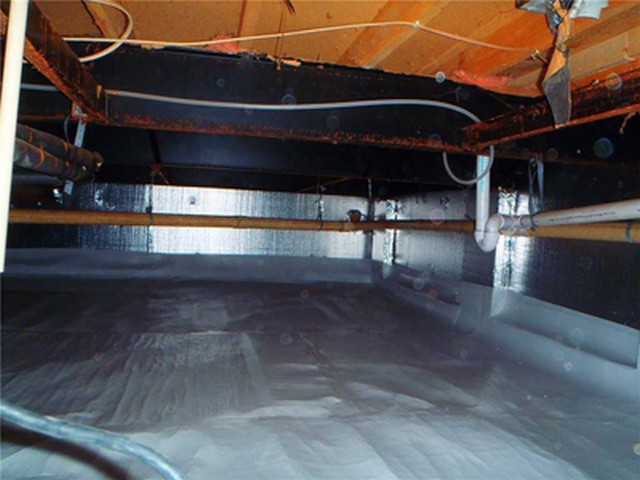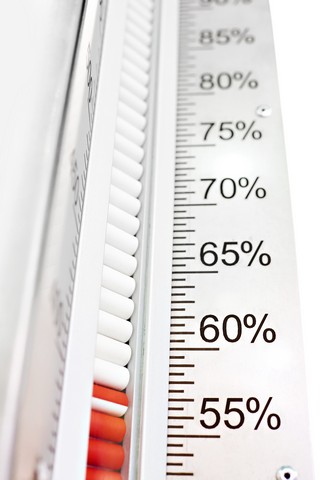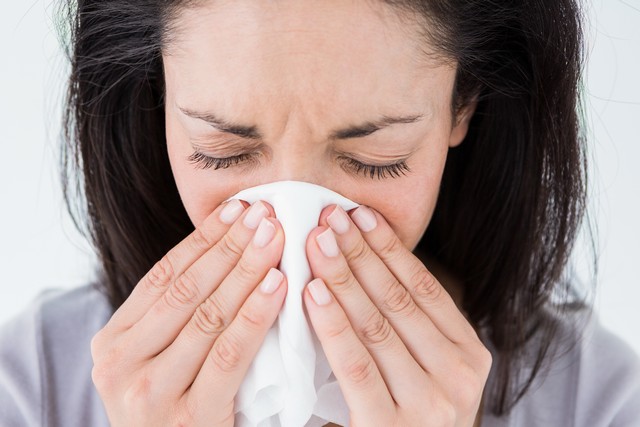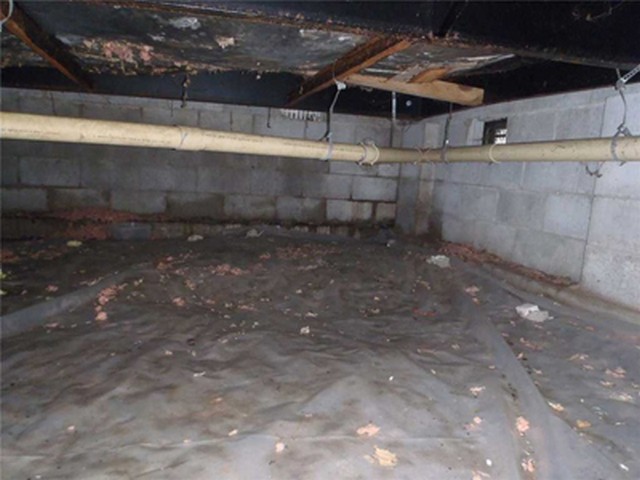Why Does Mold Grow In Your Crawlspace?

Why Does Mold Grow In Your Crawlspace?
NuTech Mold is a mold detection and removal specialist serving the Suwanee, Georgia area. One of the services we offer is crawlspace mold removal and encapsulation because the higher humidity levels leads to many phone calls from concerned home owners.
High humidity is a problem because it increases moisture, which in turn can lead to mold growth.
One area of your home susceptible to mold growth is your crawlspace.
Crawlspaces are popular because they tend to be cheaper than laying a foundation for a basement slab; make it much easier to access pipes and other utilities; and if the soil is unstable, it is simpler to install a crawlspace by bringing the house up to or above ground level.
The core problem with crawlspaces, however, is they provide the ideal environment for mold to thrive because they are dark, dirty, and humid.
Mold is a fungus that requires moisture and high humidity to grow and thrive. Like plants, mold has cells. However, unlike a plant that has chlorophyll and is able to makes it’s food through photosynthesis, mold can not feed without moisture.
Mold reproduces by releasing it’s spores, meaning mold can spread quickly in a crawlspace, especially if the temperatures range between 41 degrees Fahrenheit up to 100 degrees Fahrenheit, common in the Suwanee, Georgia area. The final ingredient mold needs to thrive is food, high cellulose materials such as wood, dust, and dirt, ample in a crawlspace.
This article has two key goals.
First, we will explain why your crawlspace could be contaminating your indoor air because of mold growth and excess humidity.
Second, we will explain what you can do to fix the problem.
Three Frequently Asked Questions About Crawlspace Humidity!

Three Frequently Asked Questions About Crawlspace Humidity!
What Is The Threshold Humidity Level For Mold Growth?
When the relative humidity of your crawlspace is 70% or higher, mold can thrive.
“Relative” humidity is the humidity level expressed in a percentage of the amount of moisture in the air needed for “saturation” (i.e. the highest level of humidity – 100%).
The amount of water the air can hold (humidity level) is dependent upon the temperature of the air itself.
When the humidity level begins to creep up past 70% relative humidity, this provides the perfect environment for mold growth!
Why Does My Crawlspace Have Condensation?
Condensation is an indication that the air within your crawlspace has reached 100%.
The air can no longer hold the moisture and it’s condensing onto the surfaces, causing the organic materials that make up your crawlspace to become damp, which will result in mold growth.
How Can I Determine If The Humidity Level Is Too High?
The easiest way to determine the relative humidity of your crawlspace is to use a hygrometer or you could install a digital thermo-hygrometer with a remote sensor to track it.
Using this tool to measure the humidity of your crawlspace is a great way to monitor the amount of moisture present.
A thermo-hygrometer measures both temperature and humidity level.
These devices are even more ideal for crawlspace atmosphere monitoring because the relative humidity level is contingent upon the moisture in the air in relation to the air’s temperature.
Being able to track the changes in both of these conditions in your crawlspace will allow you to see trends and anticipate necessary changes.
For instance, if the weather is hot during the day but the temperature plummets at night, this can cause problems for your crawlspace’s humidity levels. The daytime temperature is higher, which allows the air to hold more moisture. As night approaches and the air cools, the amount of moisture the air can hold also decreases – causing the relative humidity level to rise. A crawlspace that was at a permissible humidity level during the day can run into problems when night falls.
Being able to see these changes on your thermo-hygrometer can help you identify these types of trends so that you can respond appropriately.
Keep in mind that properly insulating your crawlspace and installing vapor barriers will help regulate the temperature and keep moisture levels down, resulting in less fluctuations in the air’s relative humidity.
The Three Key Reasons Your Crawlspace Has High Humidity Issues!

The Three Key Reasons Your Crawlspace Has High Humidity Issues!
- Water Accumulation. If your crawlspace has standing water, you probably have a drainage problem or a plumbing leak. This needs to be fixed immediately. You do not want water to accumulate in your crawlspace because this will compound your potential mold problems, not to mention as mold grows it will impact the indoor air quality of your home and health. Water damage can also weaken the foundations and walls of your home, meaning this needs to be dealt with quickly.
- Moisture Evaporating from the Ground. When homes are built with crawlspaces, most builders neglect to cover the ground, meaning that the crawlspace is covered with dirt. Dirt has moisture and as the moisture evaporates, it will increase the humidity in your crawlspace. To prevent moisture from evaporating from the ground, the easiest solution is to cover it up with a vapor barrier during crawlspace encapsulation.
- Outdoor Air Coming in through the crawlspace Vents. When you bring outdoor air into the crawlspace, the relative humidity can increase. Cool air cannot hold as much moisture as warm air, so the air that enters is now closer to its saturation point, referred to as the dew point. It might be 60% relative humidity outside, relative to a temperature of 90 degrees Fahrenheit, but when that air enters the crawlspace and cools down to 75 degrees Fahrenheit, the relative humidity jumps up to 95%.
You Need To Manage Crawlspace Humidity Levels To Ensure Healthy Indoor Air!

You Need To Manage Crawlspace Humidity Levels To Ensure Healthy Indoor Air!
Mold problems in your crawlspace will affect the indoor air quality of your home because 40% of the air in your home seeps up through the crawlspace.
There are three key reasons you need to ensure that humidity levels in your crawlspace are monitored and controlled.
- Health. If the moisture content of your crawlspace is not monitored, mold and rot will grow in the insulation or on the wooden beams. When the mold grows, it releases mycotoxins that can seep through the floorboards of your home, which in turn can cause sickness.
- Damaged Subfloor. Moisture accumulation in your crawlspace not only affects the air quality of your home, it can also seep through the ceiling of the crawlspace and damage your sub-floor. When this occurs, it will begin to warp and eventually need to repaired or replaced.
- Compromised Foundation. Moisture problems can also impact the foundation of your home. The wooden beams that hold up your home’s structure can be damaged by consistent exposure to high levels of moisture, condensation, or humidity.
Having unconditioned air below your living spaces makes your home harder to heat and cool and also provides the perfect damp setting for mold spores to breed which can cause health issues and impact the structural integrity of your home.
With this in mind, it is important to understand that simply ventilating your crawlspace is no longer a valid solution to trying to control moisture and humidity.
Rather, since your crawlspace can affect the indoor air of your home, it is clear that it needs to be treated almost as a living space of your home.
In short, areas that are in contact with your living space affect your living space.
If you are concerned that your crawlspace has humidity or mold concerns that could be impacting your indoor air and health, NuTech Mold can help you.
Got Crawlspace Mold Questions?
If you are concerned that you may have mold or humidity concerns in your crawlspace, call NuTech Mold, 470-655-1212 or send us an e-mail. We look forward to serving you! 🙂
Why Does Mold Grow In Your Crawlspace Summary!

Why Does Mold Grow In Your Crawlspace Summary!
Crawlspace #Mold: Tips and Tricks To Prevent It! https://t.co/pNxxWBiy63 PLEASE RETWEET pic.twitter.com/nINrIXErVP
— Atlanta Mold Man (@AtlantaMoldman) February 19, 2018

Recent Comments